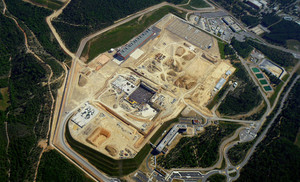The goal of ITER, which stands for International Thermonuclear Experimental Reactor, is obtaining a more cost-effective, cleaner, safer and practically inexhaustible energy source. This biggest scientific experiment of our times is bringing together scientist from seven member entities — the European Union (EU), India, Japan, China, Russia, South Korea and the United States.
The European contribution is being delivered through Agency Fusion for Energy (F4E), the EU organisation managing Europe’s contribution to ITER, which is overseeing the design and construction of the ITER buildings.
‘’Fusion holds a very important place in the Horizon 2020 programme, as well as the EU Energy Strategy for the period until 2050. Thus, Croatia’s participation in the EU Fusion Programme is an essential prerequisite for including Croatian companies in the construction of the European component of ITER and an opportunity to grab a slice of the cake worth €6.5 billion’’ - said Tadić, Croatian Research Unit coordinator.
The meeting held at the CEA gathered twenty representatives of Croatian companies such as Končar, Elka, Alfa tim, Fleksivod, BBR Adria, MIV, DIV, MKP which were introduced with the ITER upcoming business opportunities as well as with the requirements they should meet in order to take part in the project. In addition, key emphasis was made on the possibilities of a joint coordinated participation of both, small and big companies, putting together their resources, expertise and skills to win tenders.
The presentations were given by the Croatian Industry Liaison Officer (ILO) Ms Maja Pokrovac (CEA), European Fusion Laboratories' Liaison Officer (EFLO) Mr Stjepko Fazinić (RBI), a member of the F4E Governing Board and coordinator of Croatian Fusion Research Unit (CRU) Mr Tonci Tadic, Mr Tome Antičić, RBI Director, and Mr Milan Kordic from the IPC Company.
The funds that European Union has provided for the construction of ITER can be spent exclusively on tasks assigned to EU businesses through tenders published by the European Agency Fusion for Energy (F4E). “Gaining as much as 1 ‰ of work on ITER has a substantial financial gain, while the reference arising from positioning one`s company to the list of suppliers creates recognition of Croatian companies in the competitive European and global markets, with the opportunity to show their work on the world stage.” - concluded Mr Tadić.
Croatian Research Unit (CRU)
The Croatian Research Unit (CRU) is responsible for coordinating Croatia’s participation in the EU Fusion Programme as the National Fusion Entry Point, providing the public with the information regarding the participation in the Euratom Fusion Programme and the construction of ITER.
The CRU was founded by the Ruđer Bošković Institute (RBI), the Institute of Physics, the Faculty of Electrical Engineering and Computing of the University of Zagreb, the Faculty of Electrical Engineering, Mechanical Engineering and Naval Architecture of the University of Split and the University of Rijeka. The Head Office of CRU is located at the RBI with Tonči Tadić, PhD, as coordinator, while Mladen Prester, PhD, Nikola Čavlina, PhD, Dragan Poljak, PhD, and Mladen Petravić, PhD, are coordinators of fusion research at respective CRU scientific-research facilities.
The CRU research teams wishes to participate in Fusion Roadmap strategic projects and tasks, such as estimates for keeping the fusion fuel within the tokamak machine walls, determination of dust particle origin in the tokamak, the influence of fast neurons on materials and electronics, the development of superconductive magnets, laser spectroscopy of plasma, heating of the gas using radio waves and fast ions, radiation protection and nuclear energy of the fusion power plant, tritium control in the power plant environment and numerical simulations of electromagnetic fields in the tokamak.


